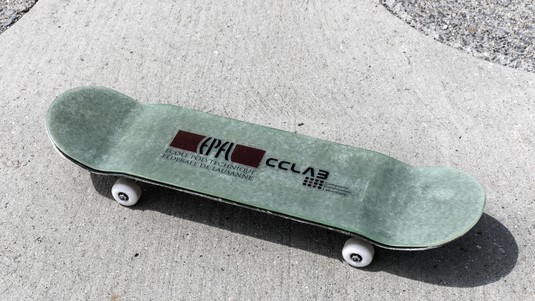An almost unbreakable skateboard made from fiberglass

Damien Sommer validated his design by making prototypes. © Alain Herzog / 2018 EPFL
For his Master’s project, a civil engineering student at EPFL dimensioned and then made a fiberglass skateboard. Applying digital techniques to the design process, this resulted in a product that is more solid than a traditional skateboard. It will be available for test rides at EPFL’s Vivapoly on 24 May.
Making a skateboard from fiberglass instead of wood makes sense: fiberglass is waterproof and more resilient than the materials used in commercially available boards, and it lends itself to new skateboard designs. This is the concept behind the Master’s project thought up by Anastasios Vassilopoulos – a senior scientist at EPFL’s Composite Construction Laboratory (CCLab), which is a hybrid civil engineering/architecture lab – and Jean-François Molinari, a full professor and head of the Computational Solid Mechanics Laboratory (LSMS), part of EPFL’s Civil Engineering Institute. People attending Vivapoly on Thursday, 24 May will be able to try out the fiberglass skateboard at the Travel GC stand.
“We wanted to come up with a project that was a little fancier than usual. So we asked a student not only to dimension a structural component, but also to make it himself and test it, to observe its strengths and weaknesses. We thought designing a skateboard would be a good idea as it was feasible to manufacture and validate the functionality of our product. In any case, the dimensioning method is similar for composite materials whether you’re making a skateboard, a bridge or an aircraft – apart from the proportions and the specifications of course,” says Vassilopoulos. For the professor, this approach has two advantages: it forced the student to go beyond the analytical level and gave him the satisfaction of making a finished product.
Damien Sommer, a civil engineering student who is also an elite volleyball player and avid skateboarder, took up the challenge. Because he is six feet tall, he needed to make a board that would not flex too much under his weight. As a result, the first part of his project was to calculate how fiberglass would behave under various loads, based on the classical theory of laminated composite materials. To do that, he used quality standards regarding the flexural rigidity of a skateboard derived by the French engineer Anthony Bert, whom he contacted.
On that basis, he was adapt the flexural rigidity of the fiberglass skateboards to the usual values preferred for the conventional wooden skateboards. Sommer validated his design by making prototypes and performing several experimental investigations, using equipment from the Structural Engineering Group (GIS/ENAC) and the Laboratory of Applied Mechanics and Reliability Analysis, part of the School of Engineering (STI).
Longer life
These days, composite materials like glass or carbon fibers reinforced polymers are only used in certain parts of a skateboard, to strengthen the basic wooden structure. However, many skis, snowboards and bicycles are made entirely of fiber reinforced polymer materials, giving them unique mechanical properties. What is the reason for not having composite skateboards yet? “Maybe skateboard manufacturers just like to stick with what they know. Developing a 100%-fiberglass skateboard requires a little more technical knowledge. Nevertheless, materials and manufacturing are not much more expensive, and a fiberglass skateboard will have a much longer life than a wooden board that absorbs moisture and always ends up breaking,” notes Sommer.
He is well aware of this problem, since he has a whole collection of broken skateboard pieces in his attic, which he upcycles into frames for sunglasses. In terms of how they feel to ride, fiberglass skateboards initially take skaters by surprise, according to Sommer: “For the first few minutes, you really have to adjust your technique, because when you land a trick, you feel the board flexing under your feet. This is when traditional wooden skateboards normally break.”
Future developments
Sommer first started working on this idea in a semester project in winter 2017, where he focused on a fiberglass-reinforced wooden skateboard. Then came his Master’s project. According to Sommer and the two professors who supervised his work, the fiberglass board could be made even more rigid, making it possible to perform more tricks. The time required to make the skateboard, its thickness and its cost could also be reduced.
“The beauty of composite materials like fiberglass reinforced polymers is that they offer much more design possibilities than conventional materials. For example, we can decide how rigid and thick we want the board to be by adjusting the fiber architecture of the material, and therefore make more versatile skateboards,” says Vassilopoulos. As a result, the quest for the perfect skateboard is continuing this spring at EPFL: a new semester project is under way and a new Master’s project, this time focusing on design and on optimizing skateboard production process is offered to interested students of EPFL.
Press kit (documents, images and videos): http://bit.ly/Skateboard_EPFL





